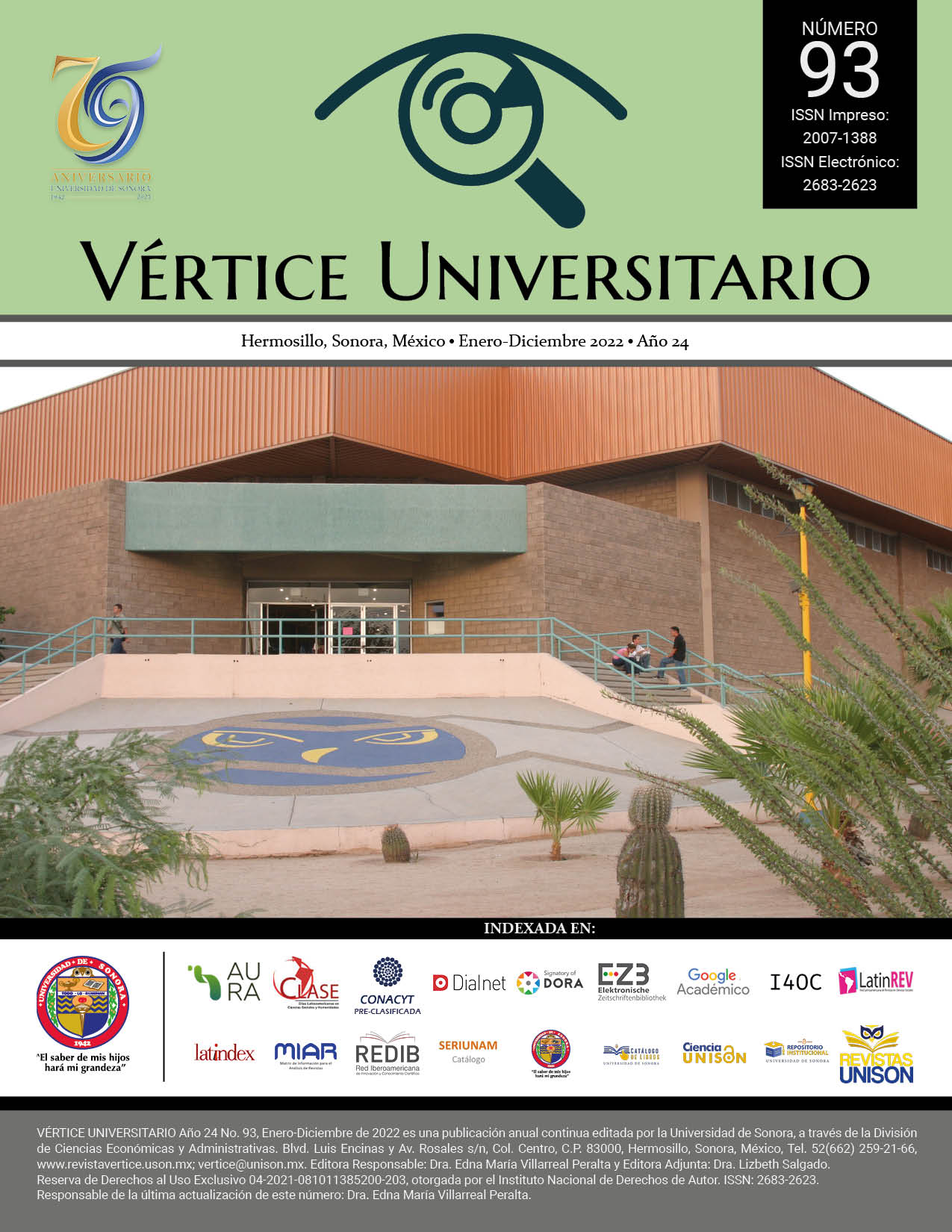Abstract
The effect of economic growth on job creation is studied, for this reason the coefficient of elasticity or intensity of employment-product is calculated and, then, a multiple regression model to identify determinants of employment. The results show that employment grows 0.75% in the region and 0.80% in the country for every 1% increase in gross domestic product (GDP), so apparently the crisis context does not affect regional or national employment; however, the analysis by sub-periods clearly shows an adverse impact on job creation at the regional level, in the states that make up the region and also in the country. According to the econometric model, job creation is explained by economic growth, foreign investment, and public spending, but not by domestic investment
References
Bracamontes J. y Camberos M. (2016). Análisis Regional del Crecimiento Económico y el Empleo en el Estado de Sonora, Nóesis, Vol. 25, Núm. 50,Julio-diciembre. Pp. 92-124
Camargo F. (2013). Reformas al mercado laboral para estimular la productividad, competitividad y calidad de vida en el Estado de México. Cofactor, Consejo de Investigación y Evaluación de la Política Social (CIEPS), IV(7): 9-93.
Carbajal, Y. y Almonte, L.(2017).Empleo manufacturero en la Región Centro de México. Una estimación por gran división, Contaduría y Administración, No. 62.Pp. 880-901.
Cruz, G. y Ríos, H. (2014).”Elasticidades producto del empleo de los trabajadores en México: un análisis por ocupaciones, revista mexicana de economía y finanzas Vol. 9 (1): 37-59.
Dornbusch, R., Fisher, S., y Startz, R. (2002) Macroeconomía. México: McGraw Hill.
Fofana, N. (2001) Employment and Economic Growth in the Cote d'Ivoire: An Analysis of Structural Determinants. african development review, 13 (1), 98-113.
Görg, H., Hornok., Montagna, C. and Onwordi, G. (2018) Employment to Output Elasticities and Reforms towards Flexicurity: Evidence from OECD Countries.IFWKiel Institute for World Economy. Disponible en: https://www.ifw-kiel.de/fileadmin/Dateiverwaltung/IfW-Publications/Holger_Goerg/Employment_to_Output_Elasticities___Reforms_towards_Flexicurity__Evidence_from_OECD_Countries/KWP_2117.pdf
INEGI (2010a). El PIB de las entidades de México, Tercer Trimestre, México.
INEGI (2010b). El desempleo por las entidades de México, Tercer Trimestre, México.
Islam, I. y Nazara, S(2000). Technical note on the Indonesian Labour Market. Estimating Employment Elasticity for The Indonesian Economy. Jakarta, Indonesia. Organización Internacional del Trabajo (OIT). pp.1-30
Kapsos, S. (2005). The employment intensity of growth: Trends and macroeconomic determinant. Employment Strategy Paper 2005/12. International Labour Office (ILO), recuperado en http://staging2.ilo.org/wcmsp5/groups/public/ed_emp/emp_elm/documents/publication/wcms_143163.pdf
Kato, E. (2004). Elasticidad producto del empleo en la industria manufacturera mexicana. Problemas del Desarrollo, vol 35(138):85-96
Keynes, J.(1936). Teoría general de la ocupación el interés y el dinero. Cuarta edición corregida y aumentada, segunda reimpresión. México, D.F.: Fondo de Cultura Económica.
Mankiw, G., Romer, D. y Weill, D.(1992). A Contribution to the Empirics of Economic Growth, the quaterrly journal of economics. May, pp.407-437
Morén Victoria y Elias Wändal (2019) The employment elasticity of economic growth A global study of trends and determinants for the years 2000-2017, bachelor thesis, Department of Economics, School of Business, Economics and Law University of Gothenburg, Disponible en: https://gupea.ub.gu.se/bitstream/2077/61745/1/gupea_2077_61745_1.pdf
Njabulo Innocent Mkhize (2019), The Sectoral Employment Intensity of Growth in South Africa, Southern African Business Review, Volume 23,#4343, 24 pp.
OECD (2001). Measuring productivity, recuperado en http://www.oecd.org/std/productivity-stats/2352458.pdf
Organización de las Naciones Unidas (2016). Objetivos del desarrollo sostenible, recuperado en http://www.un.org/sustainabledevelopment/es/objetivos-de-desarrollo-sostenible/
Organización Internacional del Trabajo (2019). Perspectivas sociales y del empleo en el mundo. Tendencias 2019 (Ginebra).
Organización Internacional del Trabajo (2015). World Employment and Social Outlook; Trends 2015(Ginebra).
Organización Internacional del Trabajo (2013). Estrategias para el crecimiento y generación de empleo de calidad, recuperado en http://www.ilo.org/wcmsp5/groups/public/---ed_emp/emp_policy/documents/publication/wcms_229836.pdf
Organización Internacional del Trabajo. 2011. Perfiles del empleo y trabajo decente en América Latina. OIT.
Pattanaik F. y Nayak N.(2011). Employment Intensity of Service Sector in India: Trend and Determinants. Kuala Lumpur: 2010 International Conference on Business and Economics Research, Vol.1, IACSIT Press, Kuala Lumpur, Malaysia
Romer, P. (1994). The origens of Endogenous Growth, Journal of Economic Perspectives, Volume 8(1):3-22.
Ríos-Almodóvar G., Carrillo-Regalado S.(2014). El empleo calificado y no calificado en la manufactura de México ante la crisis de 2009, economía, sociedad y territorio, vol. xiv, núm. 46, 2014, 687-714 xiv, núm. 46, 687-714.
Skidelsky, R. (2011).The relevance of Keynes, cambridge journal of economics, 35 (1),1-13.
Sodipe, O. & Ogunrinola, O. (2011).Employment and economic growth nexus in Nigeria. international journal of business and social science. Vol.2(11):232-239
Solow, R. (1957). Technical Change and the Aggregate Production Function. review of economics and statistics, 39(3): 312-320.
Stallings, B., y Weller, J. (2001). El empleo en América Latina, base fundamental de la política social. revista de la cepal.No.75:191-2010
Tangarife, C..(2013). La economía va bien pero el empleo va mal : factores que han explicado la demanda de trabajo en la industria colombiana durante los años 2002-2009. perfil de coyuntura económica No.21:39-60
Millán C..(2017).El impacto del crecimiento económico en el empleo de las regiones Norte y Sur-sureste de México, Tesis de Maestría en Desarrollo Regional, Centro de Investigación en Alimentación y Desarrollo.
Zuñiga, E.(2006). Mexico-United States Migration: regional and state overview. Mexico City: Conapo.

This work is licensed under a Creative Commons Attribution-ShareAlike 4.0 International License.
Copyright (c) 2021

